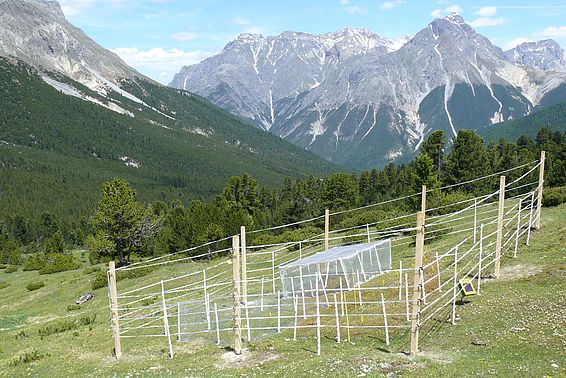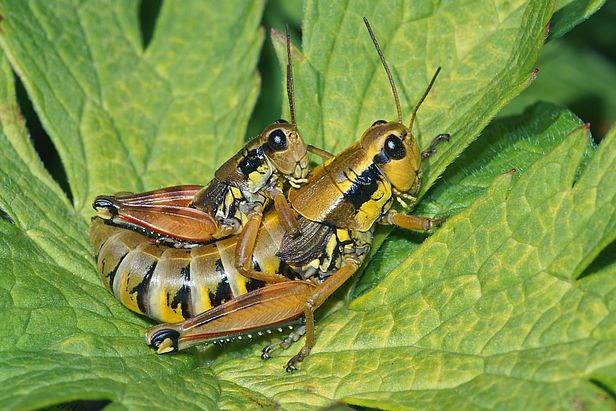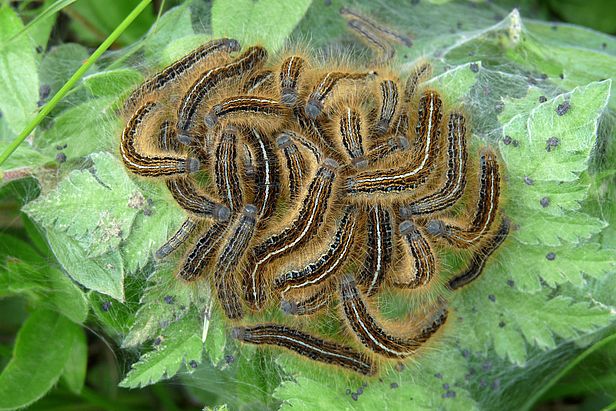10.09.2018 | News WSL
Be they large or small - herbivorous animals such as red deer, marmots, mice, snails and insects play a central role in grassland ecosystems. Particularly when all vertebrates and invertebrates are absent, food webs and nutrient cycles disintegrate and the ecosystem collapses. This is demonstrated by a study conducted by the Swiss Federal Institute for Forest, Snow and Landscape Research (WSL) in the Swiss National Park.
Until now, little was known about how the loss of animals of different body-size, ranging from the large red deer to the small aphids, affects ecological networks and therefore the functioning of an ecosystem. In a five-year experiment, WSL scientists and their research partners investigated for the first time under real conditions what happens when various herbivores are selectively excluded from grassland ecosystems. The results, published in the journal Nature Communications, suggest that in particular the loss of invertebrates could have serious consequences for grassland ecosystems.
In coordination with the park administration, the researchers installed fences in the Swiss National Park from 2009 to 2013. These fences excluded herbivores of different body-sizes from the grasslands: first large mammals like red deer, then smaller ones like marmots, hares and mice, and finally invertebrates like snails, grasshoppers and aphids. The experimental set-up reflects real-life observations: when animals die out, the largest disappear first, followed by the smaller ones.
When vertebrates disappear, invertebrates take over
When large mammals were missing, there were more interactions between the remaining biological communities and their abiotic environment, such as soil chemistry, than when they were present. For example, the exclusion of large ungulates benefited fast-growing plant species adapted to making good use of soil nutrients (biotic-abiotic interaction) at the expense of plants that tolerate heavy grazing (biotic-biotic interactions). Nevertheless, an ecosystem where large mammals – in this study red deer – are present, does not function inferior than without, it functions differently.
By contrast, when all animals – all mammals and aboveground-dwelling invertebrates - were excluded, interactions between biological communities (e.g. between plants and soil bacteria) as well as between communities and the abiotic environment (e.g. between plants and soil nutrients) decreased. The connection between above- and belowground networks became weakend. "We assumed that large animals in particular have a big impact on the system, but our results show that small invertebrates are also very important for the functioning of the system", says Anita Risch, lead author of the study and head of the WSL's Plant-Animal Interactions research group.
Invertebrates need better protection
The better the biological communities interacted and were connected with their environment, the better the ecosystem functioned. Proxies for ecosystem functioning in the National Park included nutrient availability, soil respiration and the number of plant species present. In contrast, when interactions were low, the ecosystem also functioned poorly. It becomes unstable and may be less resilient to changing environmental conditions.
The results of the experiment show the importance of the invertebrate community for ecosystem functioning, especially when larger mammals are absent. However, recently the number of invertebrate species and individuals appears to have dwindled in Switzerland and Central Europe, and not just on intensively farmed arable land. "We are worried that invertebrates are present in increasingly small numbers, even in protected areas", says Martin Schütz, co-author of the study. Both researchers warn of a loss of invertebrates, saying: "We need to increase our efforts to protect invertebrates, because they are of immense importance for coupling and functioning of our ecosystems”.
Copyright
Copyright
WSL and SLF provide the artwork for imaging of press articles relating to this media release for free. Transferring and saving the images in image databases and saving of images by third parties is not allowed.
Contact
Links and documents
Scientific publication:
Risch, A.C., Ochoa-Hueso, R., van der Putten W.H., Bump, J.K., Busse, M.D., Frey, B., Gwiazdowicz, D.J., Page-Dumroese, D.S., Vandegehuchte, M.L., Zimmermann, S., Schuetz, M. (2018): Size-dependent loss of aboveground animals differentially affects grassland ecosystem coupling and functions. Nature Communications Vol. 9, Article number: 3684 (doi:10.1038/s41467-018-06105-4).
Links:
- More about research at the Swiss National Park
- More about the project - e.g. more pictures



